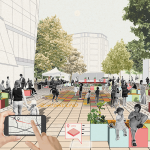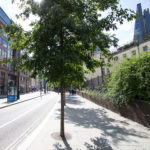After a whirlwind few weeks at Momentum, including our excitement for Transport Planning Day and our sixth birthday celebrations, we have managed to digest some of the many interesting talks, panels and conversations from the Smarter Travel LIVE conference, which took place recently in Liverpool. Given the depth and breadth of talks, conversations, and ‘speed learnings’, we’ve split our thoughts from this conference into a mini blog series. This first post gives an overview of the key trends we thought worth highlighting: MaaS, C.A.S.E, ticketing, DRT and logistics. Buckle up!
What even is Maas?
We walked into the conference with what we thought was a reasonably sound understanding of Mobility as a Service (MaaS). Little did we know about the huge number of definitions and schemes labelled as ‘MaaS’. Almost everything at a future mobility conference is MaaS: vehicles, operations, customer focus, mobile applications, ticketing and interchanges.
For many of the bus companies at the conference, for example, MaaS seems to be a mix of mobile applications and Demand Responsive Transit (on-demand minibuses serving low-density areas, not with timetables or a fixed route, but a promise of a maximum waiting time of 10 minutes and a reasonable travel time to local destinations or transport hubs).
MaaS can still feel like a mysterious object of layers and innovation cycles (infrastructure, vehicles, services), human touch and mobile technologies, mobility brokers and ticketing companies, mass transport and personalised options, impact on traffic (will making taxi and car sharing more convenient release an uncontrollable Uber-effect?) and on local transport authorities.
Connected, Autonomous, Shared and Electric: C.A.S.E
CASE is a refreshing change from the discussion on Connected and Autonomous Vehicles. From a transport planning perspective, it shifts attention away from the technology vehicles have onboard to the role of different types of vehicles in the transport systems.
Huge research budgets are being invested in this sector. What’s the effect of charging points on public realm, however? Ideas such as Recharge Parklets (repurposing underused car parks for electric recharge points, bike sharing and green rest space without impacting on footways) or the Mobility Punkt in Bremen are initial responses which seem to confirm another intervention by Martin Higgit: that future mobility will increase the importance of interchanges of all sizes (from HS2 termini to last mile micro-interchanges).
And what about the effect on the use of space and kerbside? Are we going back to the 1960s, when segregation of space was utilised to increase the speed and convenience (and therefore sales) of private vehicles? Will a race to the first CASE deployment led by automotive and technology companies overlook the progress in space design made in the last decades? What is the urban environment and design industry response to this challenge?
Going invisible: geo-fencing urban space
Why clutter streets with signs and markings which try to explain increasingly complex patterns of kerbside use? Geo-fencing applications promise to virtually allocate parts of the kerb and public realm space to different uses at different times. The Your Bike scheme in Edinburgh uses a mix of traditional stations and virtual geo-fenced stations, trying to bring together the flexibility of free-flow bike sharing with the tidier public space arrangement of fixed bike sharing stations. Grid aims to be an ecosystem to manage kerbside space for everything from logistics, to blue badge parking, to vertical farming.
It’s easy to get excited about the possibility of flexibly managing road space and public realm, and the possibilities this opens: as urban space designers, our aim should always be, when facing technological change, to put first the people that will use that space (and that technology – the boundaries are blurring here…)
Logistics goes MaaS
The very last slot of the conference was filled by logistics, a massive traffic and environmental challenge, both in cities and across regions and countries.
Established freight exchange portals are developing Uber-like services, where drivers can sign up to be informed about potential additional loads waiting for them along their current route, to pick up and deliver if convenient.
The Transport System Catapult is leading a consortium developing FreightShareLab, a potential platform that would allow carriers to share fleets and reduce the empty running of vehicles (currently around 29% of freight vehicles run empty) through a collaborative system.
As the new London Plan introduces “micro-consolidation” in Central London for major developers, the use of collaborative platforms could not only be a way of reducing trips through consolidation, but also to a way to improve the utilisation of large-scale assets such as basement service yards. Potentially transforming them from a cost to a revenue-generating asset.
Devolution! (let each region find its own way forward)
Each of the two mornings kicked off with Metro Mayoral talks, firstly by Steve Rotherham, Mayor of Liverpool, and then by Andy Burnham, Mayor of Manchester. Despite two very different approaches (Andy Burnham’s Manchester is embarking on the nation’s most ambitious cycling investment programme and Liverpool is focusing on heavy rail investment, building on the success of Merseyrail) and on public transport network integration, all the northern leaders could agree on is the lack of powers and money devolved from Central Government!
With long-standing operations from London (Transport for London and London Overground) to Liverpool (Merseytravel) and new initiatives such as the integrated Transport for the North ticketing, we can certainly see the value in devolution.
Transport Technology: A cautionary tale
An interesting reflection we heard during the conference was that, as ever, the better we make our transport systems, and the more technologically advanced they become, the further people are able and willing to travel. This does, and very much has, led us to increase the distance between different places and destinations, undermining the vibrancy of large cities and letting down less-mobile users or those who do not own a car by taking away their community and local services, confined to larger towns and shopping centres.
Transport innovation, then, is not simply a race to the first deployment of some form of technology or application, but a powerful tool to support the re-creation of new centralities, bringing community and services to the (currently) least-connected areas







